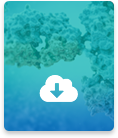
Monitoring IBD disease activity with serum marker LRG
LRG monitors disease activity in inflammatory bowel disease (IBD) receiving adalimumab
Inflammatory bowel disease (IBD), including Crohn’s disease and ulcerative colitis affects millions of individuals worldwide. IBD is caused by chronic inflammation in the gut. Though biologics such as TNF-α inhibitors (e.g. adalimumab) are highly effective in the treatment of IMD they can lose their efficacy over time. A recent report identifies LRG (leucine-rich alpha-2 glycoprotein), a novel serum biomarker, to be useful in monitoring disease activity in IBD patients. LRG is strongly associated with mucosal healing and it better reflects endoscopic activity during adalimumab treatment than C-reactive protein (CRP) and fecal calprotectin (fCal). Click here to learn more.
Check out the Biomedica LRG ELISA
- RELIABLE – full validation package
- CONVENIENT – assay range optimized for clinical samples
- EASY – results in 3 h, all reagents included
Monitoring IBD disease activity with serum marker LRG
Leucine-Rich Alpha-2 Glycoprotein May Be Predictive of the Adalimumab Trough Level and Antidrug Antibody Development for Patients with Inflammatory Bowel Disease: A Sub-Analysis of the PLANET Study. Yanai S Digestion. 2021;102(6):929-937. doi: 10.1159/000517339. Epub 2021 Jul 16. PMID: 34350873; PMCID: PMC8619792. Full text link .
Abstract link
Introduction: The aim of this study was to examine whether biomarkers are predictive of the adalimumab (ADA) trough level and antidrug antibody development in patients with Crohn’s disease (CD) and ulcerative colitis (UC). Methods: Using data obtained in a prospective, multicenter, observational study (PLANET), we assessed serial changes in a novel biomarker – leucine-rich alpha-2 glycoprotein (LRG) – during ADA treatment for patients with active CD and UC. We measured serum LRG, C-reactive protein (CRP), and fecal calprotectin (fCAL) at weeks 0, 12, 24, and 52. The ADA trough level and anti-ADA antibody (AAA) were also measured at weeks 12 and 52. Correlations between the ADA trough level, AAA, and biomarkers were examined. Results: In all, 34 patients with CD and 47 patients with UC were enrolled. The ADA trough level at week 12 or at the time of ADA withdrawal was 8.5 ± 3.9 in the AAA-negative group (n = 70) and 2.9 ± 2.7 μg/mL in the AAA-positive group (n = 8) (p < 0.0001). The ADA trough level at week 12 or at the time of ADA withdrawal was associated with pretreatment LRG (p = 0.0437 and r = -0.23). Conclusion: LRG, rather than CRP or fCAL, may be a marker for predicting the trough level of ADA for patients with CD and UC treated with ADA.
Monitoring IBD disease activity with serum marker LRG
Related publications:
Leucine-rich alpha-2 glycoprotein is a potential biomarker to monitor disease activity in inflammatory bowel disease receiving adalimumab: PLANET study. Shinzaki S et al., J Gastroenterol. 2021. 56(6):560-569. doi: 10.1007/s00535-021-01793-0. Epub 2021 May 3. PMID: 33942166; PMCID: PMC8137624.
Abstract link
Background: This multicenter prospective study (UMIN000019958) aimed to evaluate the usefulness of serum leucin-rich alpha-2 glycoprotein (LRG) levels in monitoring disease activity in inflammatory bowel disease (IBD). Methods: Patients with moderate-to-severe IBD initiated on adalimumab therapy were enrolled herein. Serum LRG, C-reactive protein (CRP), and fecal calprotectin (fCal) levels were measured at week 0, 12, 24, and 52. Colonoscopy was performed at week 0, 12, and 52 for ulcerative colitis (UC), and at week 0, 24, and 52 for Crohn’s disease (CD). Endoscopic activity was assessed using the Simple Endoscopic Score for Crohn’s Disease (SES-CD) for CD and the Mayo endoscopic subscore (MES) for UC. Results: A total of 81 patients was enrolled. Serum LRG levels decreased along with improvements in clinical and endoscopic outcomes upon adalimumab treatment (27.4 ± 12.6 μg/ml at week 0, 15.5 ± 7.7 μg/ml at week 12, 15.7 ± 9.6 μg/ml at week 24, and 14.5 ± 6.8 μg/ml at week 52), being correlated with endoscopic activity at each time point (SES-CD: r = 0.391 at week 0, r = 0.563 at week 24, r = 0.697 at week 52; MES: r = 0.534 at week 0, r = 0.429 at week 12, r = 0.335 at week 52). Endoscopic activity better correlated with LRG compared to CRP and fCal on pooled analysis at all time points (SES-CD: LRG: r = 0.636, CRP: r = 0.402, fCal: r = 0.435; MES: LRG: r = 0.568, CRP: 0.389, fCal: r = 0.426). Conclusions: Serum LRG is a useful biomarker of endoscopic activity both in CD and UC during the adalimumab treatment.
Leucine-rich alpha-2 glycoprotein as a marker of mucosal healing in inflammatory bowel disease. Yasutomi E et al., Sci Rep. 2021 May 27;11(1):11086. doi: 10.1038/s41598-021-90441-x. PMID: 34045529; PMCID: PMC8160157. Full text link.
Abstract link
Leucine-rich alpha-2 glycoprotein (LRG) may be a novel serum biomarker for patients with inflammatory bowel disease. The association of LRG with the endoscopic activity and predictability of mucosal healing (MH) was determined and compared with those of C-reactive protein (CRP) and fecal markers (fecal immunochemical test [FIT] and fecal calprotectin [Fcal]) in 166 ulcerative colitis (UC) and 56 Crohn’s disease (CD) patients. In UC, LRG was correlated with the endoscopic activity and could predict MH, but the performance was not superior to that of fecal markers (areas under the curve [AUCs] for predicting MH: LRG: 0.61, CRP: 0.59, FIT: 0.75, and Fcal: 0.72). In CD, the performance of LRG was equivalent to that of CRP and Fcal (AUCs for predicting MH: LRG: 0.82, CRP: 0.82, FIT: 0.70, and Fcal: 0.88). LRG was able to discriminate patients with MH from those with endoscopic activity among UC and CD patients with normal CRP levels. LRG was associated with endoscopic activity and could predict MH in both UC and CD patients. It may be particularly useful in CD.
Therapeutic monitoring of adalimumab at non-trough levels in patients with inflammatory bowel disease. Kato M et al., PLoS One. 2021 Jul 9;16(7):e0254548. doi: 10.1371/journal.pone.0254548. PMID: 34242369; PMCID: PMC8270420. Abstract link.
 Download biomedica product list
Download biomedica product list